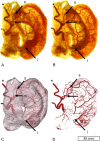Peri-arterial Autonomic Innervation of the Human Ear
- PMID: 30065349
- PMCID: PMC6068185
- DOI: 10.1038/s41598-018-29839-z
Peri-arterial Autonomic Innervation of the Human Ear
Abstract
Auricular vasomotor responses are considered to be signs of clinical conditions including migraine. The mechanisms of auricular vasomotor control are still debatable. This study aimed at investigating perivascular co-transmitters of vasomotor control in the auricle. Another aim was to provide three-dimensional arterial maps of the auricle, as a proxy of periarterial autonomic innervation. Twelve paired human auricles were used to visualize the arteries following Spalteholz clearing and μ-CT-based reconstruction. Perivascular innervation staining was conducted using anti-tyrosine hydroxylase (TH), anti-neuropeptide Y (NPY), anti-vasoactive intestinal peptide (VIP) and anti-choline acetyl transferase (ChAT). The combined Spalteholz technique and μ-CT revealed a highly consistent arrangement of the auricular vasculature. The superficial temporal (STA) and posterior auricular artery (PAA) supply the helical rim arcade and arcade, with the STA mainly forming the superior and the PAA forming the middle and inferior auricular artery. Co-existence of sympathetic NPY+ and TH+ terminals mediating vasoconstriction, and VIP+ and ACh+ indicating cholinergic vasodilatation, was found in the perivascular zone. The presence of both sympathetic vasoconstriction and cholinergic co-innervation for active vasodilatation was shown in the perivascular auricular zone. Assuming that the highly-consistent vasculature gives way to these terminals, this periarterial innervation may be found spread out across the helix.
Conflict of interest statement
The authors declare no competing interests.
Figures


References
MeSH terms
Substances
LinkOut - more resources
Full Text Sources
Other Literature Sources
Research Materials
Miscellaneous

